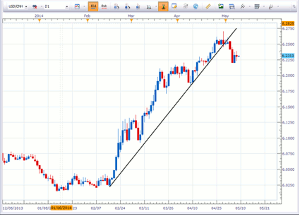A common mistake among traders in trendless markets is impatience, so Jeremy Wagner of DailyFX Education offers two simple ways to correct overcome it.
If you hang around trading communities long enough, you’ll hear the wiser traders encouraging the newer traders about trading with patience and removing emotions.
It sounds simple, especially if you are practicing with a demo account. However, see what happens to your patience when your money is on the line!
A few weeks ago, we covered three common mistakes traders make during trendless markets and how to correct them. Over the next few minutes, I want to expand on the third mistake noted in that piece to help equip you with two actionable methods that can promote more patient trading.
One common mistake of traders during trendless markets is that they become impatient and close their trades prior to the stop loss or target being reached. During trendless markets, patterns and waves are slower to develop which breeds the impatience we feel.
To balance that impatience, practice these two methods below.
“Remember the clever speculator is always patient and has a reserve of cash.” Jesse Livermore
Use Conservative Amounts of Leverage
We assume that trades which have historically reached their profit targets quickly should continue indefinitely into the future. Therefore, if prices aren’t hitting their targets quickly, it must obviously not be a good trade so we exit prematurely.
This impatience is in part due to expecting the next trade to be a big home run. As a result, we’ll place a trade size a little larger than normal so as to squeeze a little extra juice out of the trade in case it goes nowhere. However, during this process, the trader ends up risking a significant portion of their account on the outcome of that one trade.
Remember, a 25% loss requires a 33% return to get back to break even. If a 25% loss in a fast moving market is difficult enough to overcome, imagine how challenging it would be to overcome a 25% loss in a slow moving market. Therefore, de-emphasize each trade and think of the next trade simply as the first of ten trades rather than the next homerun.
You can reduce the emphasis by implementing less than 10x effective leverage. Effective leverage is simply taking the total notional trade size and dividing it by your account size. The result will indicate how many times you have your equity levered. According to our research, we recommend implementing less than ten times effective leverage.
Incorporating smaller trade sizes and less leverage will alleviate the stress of having to produce a profitable trade. As a result, you’ll be more likely to let the trade develop and let the trade evolve in the way the patterns indicate.
Analyze Longer-Term Patterns
Another way to become more patient is to remember what the longer term chart patterns are suggesting.
Recently, I had been trading the USD/MXN extensively and the movement was quite choppy. It had been a while since I stepped back to review the daily chart. Since it had been several months, the pattern on the daily chart cleared up, which affected my near-term bias on the trades.
Sometimes, we can get caught up in the minutia of the day to day. Then, we forget what the longer-term patterns are suggesting and lose that perspective in trading.
That is the benefit you get with longer-term chart analysis. Longer charts help you develop a bias of direction. With each trade you make, there should be some method of determining a bias.
For example, trend traders look at the longer-term trend and filter their trades accordingly. Range traders will see the longer-term levels of support and resistance and make buying decisions near support and selling decisions near resistance.
The point is that the market tries to lull us to sleep, yet the longer-term patterns are still playing out. What better time is there to analyze charts than while the markets are slow!
USD/CNH Daily Chart

(Created using FXCM’s Marketscope 2.0 charts)
Click to Enlarge
A recent example of a longer-term chart would be of the USD/CNH. We wrote about the trends in that pair during our finding trends in trendless market series.
There are several good longer-term patterns exhibiting the potential for something big to happen. Keep an eye on GBP/AUD, USDOLLAR, AUD/NZD, and silver.
In summary, train yourself to be more patient by utilizing less than ten times effective leverage and occasionally reviewing longer term charts for perspective.
By Jeremy Wagner, Head Forex Trading Instructor, DailyFX Education





















